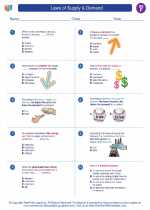National Curriculum Standards for Social Studies (NCSS)
PRODUCTION, DISTRIBUTION, AND CONSUMPTION
SOCIAL STUDIES PROGRAMS SHOULD INCLUDE EXPERIENCES THAT PROVIDE FOR THE STUDY OF HOW PEOPLE ORGANIZE FOR THE PRODUCTION, DISTRIBUTION, AND CONSUMPTION OF GOODS AND SERVICES.
KNOWLEDGE - Learners will understand:
How markets bring buyers and sellers together to exchange goods and services.
How goods and services are allocated in a market economy through the influence of prices on decisions about production and consumption.
National Standards for Civics and Government (NSCG)
What are the foundations of the American political system? What are the distinctive characteristics of American society?
Distinctive characteristics of American society. Students should be able to identify and explain the importance of historical experience and geographic, social, and economic factors that have helped to shape American society. To achieve this standard, students should be able to
Explain important factors that have helped shape American society
Market economy
National Content Standards in Economics (NCSE)
Allocation
Students will understand that different methods can be used to allocate goods and services. People acting individually or collectively must choose which methods to use to allocate different kinds of goods and services. Students will be able to use this knowledge to evaluate different methods of allocating goods and services, by comparing the benefits to the costs of each method.
At the completion of Grade 8, students will know the Grade 4 benchmarks for this standard, and also that:
There are essential differences between a market economy, in which allocations result from individuals making decisions as buyers and sellers, and a command economy, in which resources are allocated according to central authority.
National economies vary in the extent to which they rely on government directives (central planning) and signals (prices) from private markets to allocate scarce goods, services, and productive resources.
As consumers, people use resources in different ways to satisfy different wants. Productive resources can be used in different ways to produce different goods and services.
Markets and Prices
Students will understand that a market exists when buyers and sellers interact. This interaction determines market prices and thereby allocates scarce goods and services. Students will be able to use this knowledge to identify markets in which they have participated as a buyer and as a seller and describe how the interaction of all buyers and sellers influences prices. Also, predict how prices change when there is either a shortage or surplus of the product available.
At the completion of Grade 8, students will use this knowledge to:
Explain what will happen to the relative price of a good if it becomes increasingly scarce.
Identify examples of products for which the price fell because sellers did not sell all they had produced at the initial price; identify examples of other products for which the price rose because consumers wanted to buy more than producers were producing at the initial price.
Role of Prices
Students will understand that prices send signals and provide incentives to buyers and sellers. When supply or demand changes, market prices adjust, affecting incentives. Students will be able to use this knowledge to predict how changes in factors such as consumers’ tastes or producers’ technology affect prices.
At the completion of Grade 8, students will know the Grade 4 benchmarks for this standard, and also that:
An increase in the price of a good or service encourages people to look for substitutes, causing the quantity demanded to decrease, and vice versa. This well- established relationship between price and quantity demanded, known as the law of demand, exists as long as other factors influencing demand do not change.
At the completion of Grade 8, students will know the Grade 4 benchmarks for this standard, and also that:
An increase in the price of a good or service encourages producers to supply more, and vice versa. This relationship between price and quantity supplied is normally true as long as other factors influencing costs of production and supply do not change.
National Center for History in Schools (NCHS)
World History Content Standards
Era 9: The 20th Century Since 1945: Promises and Paradoxes
The search for community, stability, and peace in an interdependent world.
The student understands how liberal democracy, market economies, and human rights movements have reshaped political and social life.

 Worksheet/Answer key
Worksheet/Answer key
 Worksheet/Answer key
Worksheet/Answer key
 Worksheet/Answer key
Worksheet/Answer key
